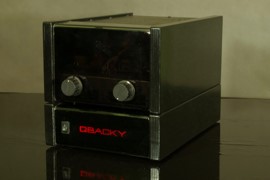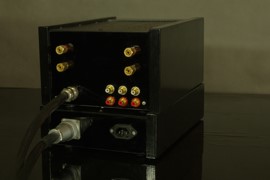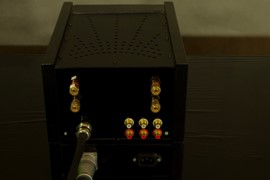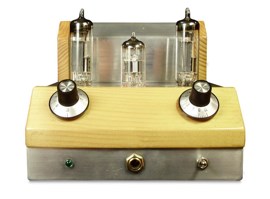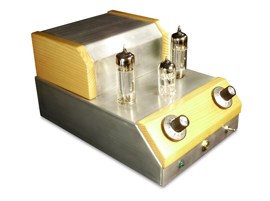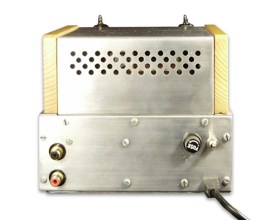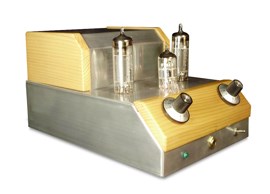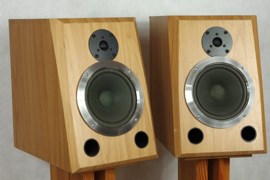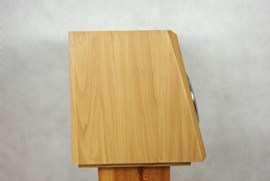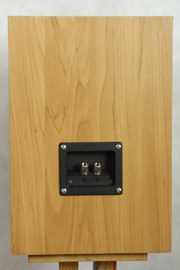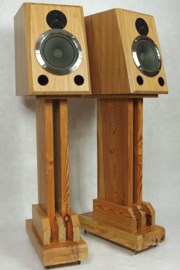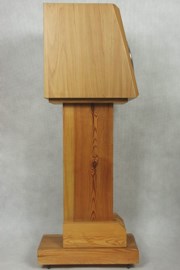Hybrid Amplifier
Tubes and Transistors
Two worlds
Our world is not perfect. Perfect solutions and perfect components are not existing. Each technology has got it's advantages and disadvantages. Therefore, there are ideas connecting seemingly not matching groups, like semiconductors and vacuum tubes.
Vacuum tubes has got extraordinary sound. Every audiphile or music lover it know. But it has got serious shortcoming - it can't drive directly typical low impedance loudspeakers. by reason of that are special transformers used, with adversely impact to recorded music. Alternative solution is to use a transistors instead of transformers. It simplyfing construction and, the most important, allow to enjoy vacuum tube's sound.
Construction
Described here amplifier has got separated power supply, to reduce transformer's hum to the minimum. The system itself is extremely simplified to shorten the sound path as much as possible from sources to speakers.
As a reinforcing element, a combined lamp (trode with pentode) of the PCF802 type is used. A complementary pair of MOS-FET transistors works at the output stage. The whole is controlled entirely manually - switches and potentiometer. Only the relays are controlled by a simple automation system. Immediately after switching on the power supply, the voltage is only applied to the lamps, and only after a few dozen seconds the anode voltage is connected. This solution significantly extends the life of the lamps.
Sound
The biggest advantage of the amplifier described here is sound in the midrange range. Played vocals can be so enchanting that it is difficult to convince to return, to transistor constructions. Just the voice appears on them metallic and cold. That's all advantages. Sadly, other ranges are more worse. Basses are not too deep, trebles are muffled and stereophony is very narrow.
The project is remitted, at the moment
Technical data:
Pass bandwidth: -
Non-linearity distortions: -
Signal to noise: -
Crosstalk: -
Power consumption: <250W
Dimensions (L/W/H): -
Weight: 9,3kg
<div class="ppy-outer"> <div class="ppy-stage"> <div class="ppy-nav"> <a class="ppy-prev" title="Previous image">Previous image</a> <a class="ppy-switch-enlarge" title="Enlarge">Enlarge</a> <a class="ppy-switch-compact" title="Close">Close</a> <a class="ppy-next" title="Next image">Next image</a> </div> </div> </div> <div class="ppy-caption"> <div class="ppy-counter"> Image <strong class="ppy-current"></strong> of <strong class="ppy-total"></strong> </div> <span class="ppy-text"></span> </div>
Headphone Amplifier
Play of vacuum tubes
100% vacuum tubes
Constructions based on vacuum tubes are very popular at last time. Therefore we succummbed the temptation to create something own, too. In consequence, a headphone amplifier has been developped. It is cheaper than 'big" amplifier, yet it indulge to play of vacuum tubes.
Construction
The prototype was based on one double triode PCC88 and two combined PCL805. The first one, was used as a voltage amplifier for both channels. Whereas, triode included to the PCL805, was used as the second voltage amplifier. Penthode - as a power amplifier.
Anodes are supplied with several times filtered voltage with RLC components. Heaters has got stabilised 0,3A power supply.
Sound
The first impression was confusing: good, it is working, but something is wrong. Where is the vacuum tubes magic? The sound was flat, absolutely without expression. No matter what kind of music was used. Thus, nothing left but rebuilt the amplifier. The PCC88 was removed in final solution - sound took proper colouration. One could say: it is behave like typical 'lamp' - with warm middletone, not irritating trebles and quite lazy basses. It can give a lot of pleasure. It has got one negative - low output power. So we decided to have put it on ice.
Technical data:
Pass bandwidth: -
Non-linearity distortions: -
Signal to noise: -
Crosstalk: -
Power consumption: -
Dimensions (L/W/H): -
<div class="ppy-outer"> <div class="ppy-stage"> <div class="ppy-nav"> <a class="ppy-prev" title="Previous image">Previous image</a> <a class="ppy-switch-enlarge" title="Enlarge">Enlarge</a> <a class="ppy-switch-compact" title="Close">Close</a> <a class="ppy-next" title="Next image">Next image</a> </div> </div> </div> <div class="ppy-caption"> <div class="ppy-counter"> Image <strong class="ppy-current"></strong> of <strong class="ppy-total"></strong> </div> <span class="ppy-text"></span> </div>
Loudspeakers
Monitors
Maximum wrinkling out
A loudspeakers are the most important part of electroacoustic set. If are poor, then can effectively spoil the listetning. No matter how good is the amplifier and the CD player. On the second hand, buying extremely expensive one's to cheap electronic equipment is nonsense. A loudspeakers aren't meeting up to its potential, then.
Construction
The idea was to construct inexpensive monitors using popular loudspeakers. The choice fell on Tonsil's products: GDN16/30 and GDWK8/50. They were placed in a 18mm thick MDF-molded housing. The front wall has a double thickness - 36mm. This allowed to significantly reduce the vibrations and thus the coloration of the sound.
The crossover has been specially designed for it. It consists of air coils and foil capacitors.
Sound
The monitors sound very balanced, correctly reproducing mid and high tones. Concededly, the bass will not cause earthquakes, but also do not have to imagine it. Considering all costs of the housing and crossover, the sound is not very satisfying. Simply, too cheap speakers have been used.
There is a plan to modernize the project for better speakers. At the moment, it is difficult to say when it will happen.
Technical data:
Impedance: 8Ω
Max. power: -
Pass bandwidth: (-3dB)
Dimensions (L/W/H): -
Weight: -
<div class="ppy-outer"> <div class="ppy-stage"> <div class="ppy-nav"> <a class="ppy-prev" title="Previous image">Previous image</a> <a class="ppy-switch-enlarge" title="Enlarge">Enlarge</a> <a class="ppy-switch-compact" title="Close">Close</a> <a class="ppy-next" title="Next image">Next image</a> </div> </div> </div> <div class="ppy-caption"> <div class="ppy-counter"> Image <strong class="ppy-current"></strong> of <strong class="ppy-total"></strong> </div> <span class="ppy-text"></span> </div>

